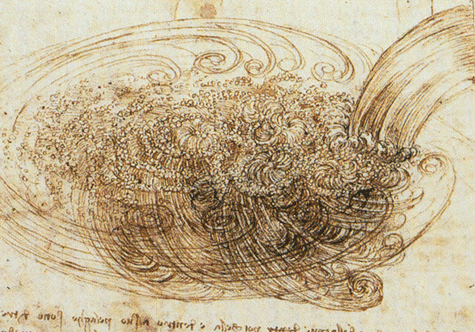Welcome to the GEOS 353, Environmental Fluid Mechanics, webpage for the Fall 2021 semester.

Credit: Leonardo da Vinci, Studies of Turbulent Water
This page will be updated every few days as the course progresses...
Prerequisites: PHYS 202A or 204A and MATH 109 or 120.
University Catalog Description: Fluids (gases and liquids) are ubiquitous and play central roles in shaping the environment and transporting heat, momentum, pollutants, and constituents that support life and control climate. This course provides students with an introduction to fundamental concepts in fluid mechanics and an illumination of the vital and fascinating, and often non-intuitive, world of fluid phenomena.
NOTE: To accomodate students who are not on campus or wish to continue isolating, this course has two simultaneous sections: one on-line and one in-person. Lectures will also be recorded.
Fall 2021 Lectures: Tues & Thurs, 12:30 - 1:45 PM. Location: SCI computational lab and on-line.
Office hours: M & W from 10 AM - 12 PM or by appointment. (Please e-mail me to schedule something.)
Tues., Aug. 24: Slopes, ordinary derivatives, partial derivatives, vectors.
Thurs., Aug. 26: Gradients (directional derivatives), Begin flux-gradient relationships.
Tues., Aug. 31: Shear stress, momentum flux, and Newton's law of viscosity.
Thurs., Sept. 2: Introduction of Cauchy stress tensor. Newton's second law.
Tues, Sept. 7: Differential shear stress. Begin discussion of index notation.
Thurs., Sept. 9: Einstein summation notation. Cauchy's momentum equation. Divergence.
Tues., Sept. 14: Quiz #1. Then, development of the constitutive equation for Newtonian fluid.
Thurs., Sept. 16: Discuss mass continuity equation. Then, derive PGF and viscous force term.
Tues., Sept. 21: Derivation of the diffusion equation and relationship to viscous force term.
Thurs., Sept. 23: Eulerian control volume, advection terms, begin true and apparent gravity.
Tues., Sept. 28: True and apparent gravity. Then begin rotation: inertial and non-inertial reference frames.
Thurs., Sept. 30: Using determinates and derive Coriolis term in vector form.
Tues., Oct. 5.: Component form of Coriolis (latitude dependent). Integration and examples of deflection.
Thurs., Oct. 7: Levi-Civita symbol. Then begin turbulence: characteristics of Turbulence.
Fri., Oct. 8: Quiz #2.
Tues., Oct. 12: Complete characteristics of Turbulence. Reynolds number and the transition to turbulence.
Thurs., Oct. 14: Begin Reynolds decomposition and rules of averaging.
Tues., Oct. 19: Reynolds averaging Navier-Stokes and derivation of the Reynolds stress term.
Thurs., Oct. 21: Covariance and Reynolds stress.
Tues., Oct. 26: K-theory and eddy viscosity. Smagorinsky subgrid scale parameterization.
Thurs., Oct. 28: Scale-analysis for synoptic scale weather: geostrophic and hydrostatic balances.
Tues., Nov. 2: Quiz #3. Density variations and buoyancy in fluids.
Thurs., Nov. 4: Stratification and effects of it. Derivation of Poisson's law and potential temperature.
Tues., Nov. 9: Rossby number and first use of rotating tank to demo "rigid fluid" and Taylor columns.
Thurs., Nov. 11: Veteran's Day: no classes.
Tues., Nov. 16: Derivation of Taylor-Proudman theorem. Then resume potential T and static stability.
Thurs., Nov. 18: Derivation of Brunt-Väisälä frequency and discussion of gravity waves.
Tues., Nov. 23: Thanksgiving: no classes.
Thurs., Nov. 25: Thanksgiving: no classes.
Tues., Nov. 30: Boundary layers and begin derivation of the Ekman spiral.
Thurs., Dec. 2: Quiz #4. Complete derivation of Ekman spiral. Demo Ekman flow in rotating tank.
Tues., Dec. 7: Review week
Thurs., Dec. 9: Review week
Tues., Dec. 14: Comprehensive Final Exam, 2:00 - 3:50 PM
Dr. Mayor's page
